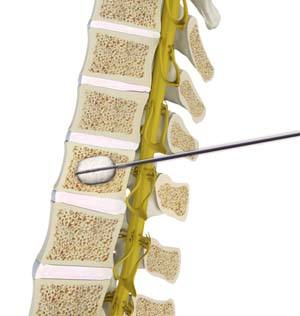Kyphoplasty

Kyphoplasty is a minimally invasive procedure for the management of painful vertebral compression fractures. Vertebral compression fractures are usually caused due to osteoporosis, spinal tumours and traumatic spinal injuries, all of which can weaken the bone, leading to collapse of the vertebra resulting in a wedge-shaped vertebra. The collapsed vertebra causes pain and spinal deformity and also hampers physical activity affecting the patient’s quality of life. Kyphoplasty is recommended in these patients when nonsurgical treatments, even for 2-3 months, do not provide any relief from symptoms.
Kyphoplasty restores the height of the collapsed vertebra with the help of a special balloon. This balloon is introduced and inflated in the collapsed vertebra followed by injection of bone cement into the space created, after removal of the balloon. The bone cement strengthens the vertebra and corrects the deformity resulting in significant pain relief immediately after the procedure. The bone cement also helps prevent further fractures. Being a minimally invasive procedure Kyphoplasty provides additional advantages of minimal scars, shorter hospital stay, quicker recovery and quicker return to normal activities.
Along with kyphoplasty, treatment of the underlying cause of vertebral compression fractures is also very important. In an osteoporotic patient, every vertebral compression fracture increases the risk for future vertebral compression fractures by approximately five times.
Procedure of Kyphoplasty
The patient is sedated and placed face down, on the operating table. After administration of anesthesia, two small incisions are made on either side of the fractured vertebra. Two large bore needles are inserted through the two incisions into the vertebral body, under fluoroscopic guidance; sometimes only a single needle may be inserted. Special balloons are then inserted through the needles, into the vertebra and cautiously inflated till the height of the collapsed vertebra is restored. The balloons are then deflated and removed, creating an empty space within the vertebra. The bone cement is then slowly injected, into the empty space. Care is taken to avoid leakage of the bone cement, into the surrounding areas. The injected cement quickly hardens and restores the height of the compressed vertebra. The needles are withdrawn and the small skin incisions are closed.
Procedure for each collapsed vertebra takes about an hour. Thus, time taken for the complete procedure depends on the number of the vertebra to be treated.
After the Surgery
Patients are usually discharged on the same day of the surgery but occasionally will have to stay overnight in the hospital. The patients must get somebody to drive them home, after the surgery. Driving should be resumed only when allowed by the surgeon. For faster recovery, the incision should be kept clean and dry and the discharge instructions should be followed diligently. In case of any complication or related health problem, the surgeon must be informed at the earliest.
Risk and Complications of Kyphoplasty
Every surgical procedure is associated with some risk. Kyphoplasty is a relatively safe surgical procedure though some of the risks and complications associated with kyphoplasty include infection, bleeding, leakage of bone cement into the surrounding areas and nerve or spinal cord injury. Complications may also be related to the anesthesia administered.
